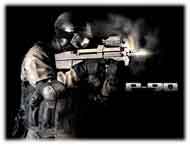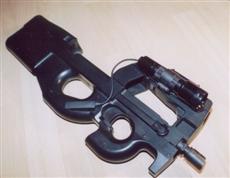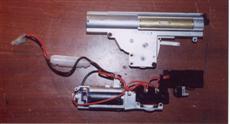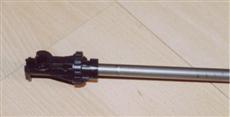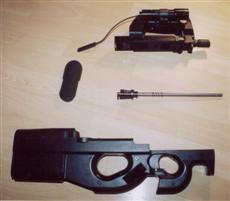I got mine last year direct from Hong Kong, complete with 3 Hicap magazine, 2 9.6V batteries, Systema FTK (Full Tune-up Kit) and a KM TN barrel. Upon receiving it and subsequent testing I decided to put pen to paper and write up my initial experiences with the standard and upgraded weapon – without the hype of the initial launch which I feel may have impaired the impartiality of some of the early reviewers. Reality Bites Reviewing the Airsoft P-90 would be impossible without mentioning the history of the real steel version – well nearly. Suffice it to say I am not going to cover it in detail except to say the FN P-90 was designed and manufactured around a research contract issued by NATO in response to their growing concerns about the proliferation of body armour on the battlefield. The resulting weapon, the P-90, was initially intended as a compact weapon for crews, chefs etc… But its compact design, high accuracy and high armour penetration have endeared it to the Special Operations communities in the Western Hemisphere. If you want to read more about the real steel FN-P90 do a web search, or look to the other reviews – they go into more detail. The TM FN P-90 was initially announced just over 1 year ago, possibly in response to its increased popularity following the real steels appearance in James Bond: The World is Not Enough. Promising a new gearbox design it was eagerly awaited, and uncommon for the TM design and manufacture cycles took little over a year to see the light of day (usual cycle is 1-2 years). This rapid release was presumably due to TM wanting an unusual AEG for their 10th Anniversary. Well they got it.
Externally the P90 looks like few other weapons. An SMG, the P90 is not a classic bull pup weapon, with the trigger very much forward on the weapon. The clear magazine is unusually placed on top of the weapon. The flowing lines and organic curves on the AEG will put off some people. The front grip and pistol grip are a series of molded curves that fit very comfortably into the hand. The selector switch is located horizontally just in front of the trigger, with 3 positions (yes you guessed it; Safe, Semi and Full auto). The moulded pistol grip is heavily intergraded into the lower receiver and provides a very comfortable means by which to carry the AEG. This flows back to the rear section on the lower receiver, which houses all the working components. The upper receiver comprises of an A type frame which houses the barrel, red-dot sight, and weaver rail. With an overall length of 504mm this highly compact weapon has very few points on which to catch or hang up on foliage. Closer Detail The weapon weighs 1900 grams empty, very light but comparable to the real steel weapon. The weapon is made almost entirely from plastic, with few metal components – except the muzzle, red-dot sight and cocking handles. The upper receiver is constructed of ABS plastic (unlike the real weapon), with usual TM attention to detail. There is a relative lack of trademarks – possibly due to TM’s recent bust up with Colt over the M16 series of AEGs. There is a 20mm weaver rail mounted on the right side of the receiver – very useful for fitting lasers, Surefires etc… Further to the optical sight there are 2 sets of iron sights (catering for righties and lefties). The upper receiver houses the barrel and hop assembly – which are spring loaded for easy access and cleaning. The cocking levers are recreated accurately and are functional to the extent that the spring back when pulled. The upper receiver is fully detachable from the lower receiver care of the accurately reproduced take down system. This is achieved by removing the magazine, and pushing the take down button on the upper receiver – then pulling apart. The lower receiver houses all the vital mechanical components: gearbox, battery and trigger mechanism. All moulded ABS plastic, the lower receiver is a clamshell design with both halved glued together. The gearbox is supposed to be a new design, labelled ‘Version 6.1’. It is not a new design; rather it is an evolution of the Thompson gearbox sharing most of the internal components with the only difference being the position of the motor. One disappointment is that the lower receiver is full of voids, this means it sounds very hollow, and detracts somewhat from the realism. Operational Status With the cosmetic overview out the way, time look at the operational details of this beauty. The battery essential in operating the gun, is an 8.4V 600mah battery pack housed in the butt of the P90 above the gearbox. Access to this compartment is achieved by pressing a button on the bottom of the butt plate then sliding it down wards and off. Simple insert and connect the battery then replace the butt plate. Next you need a magazine which is locked in by guiding it between the upper receivers support struts, then locking it in place by pressing down on the butt end of it. The bonus item on the P90 is the red dot sight, powered by 2 AAA batteries that are housed within the sight itself. Secured in their bay by a locking door. With 2 brightness settings, (one for indoor and darker conditions and one for daylight conditions), it is very versatile. However the sight optics have been tinted, which reduces the light gathering capabilities of the scope and its small bore limit its effectiveness. The power switch is located on the underside of the upper receiver. This location makes changing the brightness setting difficult with a magazine locked in, since the gap is abut 11mm – a bit too small for my fingers. Combat Trials With the weapon primed it ready to test my new toy. Setting the selector to ‘1’ selected semi, and a pull of the trigger ushered forth a loud crack and sent a BB flying into the ground – forgot to adjust the HOP. The HOP is accessed via a small door located on the lower receiver above the pistol grip. Sliding back the door and twisting the knob adjust the HOP accordingly. Good news is that the HOP unit is very ridge and after putting 2 magazines through the AEG the HOP was still dead on. After setting the HOP the AEG was accurate out to 45 metres with maximum range of about 55 metres. With the semi tests out the way, full auto trials followed. As with semi everything worked well, however accuracy did suffer possibly due to the floating barrel in the upper receiver. One thing of concern was the occasional double feeding, which could be exacerbated with dodgy ammo or a dirty barrel resulting in gearbox damage. Rate of Fire (RoF) was high, which with the 300 round hicaps and EG1000 could lead to ammo shortages at inopportune moment in the middle of a firefight. However like the AUG this weapon has clear magazines that allow you to monitor the amounts of ammo you have left. This feature has been hyped again and again by AUG fans, although on the AUG it is of little use since the magazine is buried in your armpit so to check your ammo you need to remove the rifle from your shoulder – making you vulnerable. No such problem on the P90 as the magazine is right in front of you eyes!! The P90 is not the quietest AEG in the world, since the gearbox is located right next to the ear when the weapon is shouldered. The hollow clamshell body also allows sound to resonate inside it, invariably leading to an increase in noise. So the first test run was a success and the P90 proved to be accurate, lightweight, highly maneuverable and with a high rate of fire – a very desirable weapon it seems. But I have concerns about this weapons viability as a woodland weapon and about its long-term durability. Window Dressing As with most TM AEGs there are an expanding number of aftermarket accessories available for the P90. Stock TM accessories are limited to the Tracer unit, Pro Silencer, standard and Hicap magazines. Great, really imaginative. But the design of the P90 limits aftermarket accessories, since there are few modular parts that can be replaced like the M4’s. One immediate accessory CQB users should invest in is the Surefire tactical light, go with the 6P series and invest in the pressure pad. Then mount it to the weaver rail with a 20mm scope mount – it adds a whole new dimension to the tactical look. The more imaginative manufacturers like Systema and DTP have slowly been releasing several further parts and accessories like silencers (AS and Systema), Triple Sided Scope mounts (DTP), Metal Upper receivers (DTP), Full Tune Up kits (M100 & M120S – Systema), Tight bore barrels (KM), Battery holders, Sling swivels (First) and Butt extenders. Not bad, and expect more to come. Slings are catered for by Blackhawk (see BlackHawk P90 sling article), Airsoft Dynamics, Guarder and Chalker.
At HK$1500 (£130) the P90 is cheaper than the M4 series of weapons, and some of the MP5 series. This is truly outstanding considering its amongst TM's latest releases, a bargain buy that should not be missed – oh wait that’s HK street prices, the P90 retails in the UK for a average price of £225. Still cheaper than most other, older AEGs. As an above average stock AEG, it’s usable but not overly suited for long range engagement in woodland combat. Hence I bought a set of upgrades to improve upon the power and range of the AEG. So installing the Systema Full Tune up Kit (FTK), KM High accuracy barrel and trying to get the 9.6V batteries to fit was my next series of jobs. Initiating upgrade sequence. So starting off the upgrade party involves stripping down the weapon. But first examining the upgrades; the FTK includes Standard Helical gears, M100 spring, Metal bushings, High speed cylinder set, polycarbonate piston etc…
Upon replacing the gearbox in the AEG, I test fired it with a 8.4V 600maH battery. RoF was noticeably lower than before the upgrade – due to the M100 spring. But muzzle velocity increased to 335 fps, with a noticeable increase in range – up to 10 metres or so. Knowing there would be some drop off in RoF I ordered 2 custom 9.6V batteries. Both are an J-shape, held together with a metal reinforcing rod running through them. Now I have already mentioned the limited battery space, and to get these beauties to fit requires some serious modification work that is not for the faint hearted. Now you have 2 options here, keep the fuse or loose it. Usual risks apply for the removing the fuse (like damaging the gearbox), I chose to keep the fuse but had to loose the fuse box. I made an improvised fuse box out of some heatshrink tubing. Modifications have to be made to the gearbox retaining plate, battery bay and butt plate to fit the new batteries. Ideally you will want a Dremel tool, otherwise a saw and file will do. First off remove the gearbox retaining plate and cut it in half – removing the lower portion of the plate. Then cut a small portion of the remaining retaining plate at a 45 degree angle of the right side and remove the small plastic clip the keeps the wires tidy. Next up I had to stuff the wires and improvised fuse holder down the right side of the gearbox well behind the retaining plate – this is very time consuming but is doable, try removing the gearbox and guiding it in with the wires taped to the side. Next up I had to file the ribs on the back of the butt plate down so they were flush with the backing. The difficult bit follows now – you have to remove a ridge that runs down the sides and across the end of the battery bay. If you fail to remove this the 9.6V battery won’t fit at all. Now I removed it using a heated screwdriver burining it off – dangerous not only because of the possibility of burns but also from the fumes I inhailed!! Actually I don’t know of another way to get rid of the ridge - a long file, the Dremel tool extender, a chisel?? I don’t know, all I know is my mad method worked. Now all that was left was to insert the battery – still not that easy since the battery comes with wires that are over 100 mm’s long!! I tucked the wires round the side of the gearbox and the connector behind the retaining plate. This noticeably increased the RoF, beyond standard levels, a pleasing result. Now it was time to address the accuracy of the P90. I installed a KM tight bore barrel and muzzle velocity increased to 342 fps range was extended by about 5 metres, with groupings tightening up considerably.
When I was servicing my P90 after a skirmish I took the battery out of the AEG and noticed the insulation around one of the wires was cut right down to the copper flex. So I have now strengthened the cabling by repairing the damage with electrical tape then covering both with heatshrink tubing to provide added protection. I presume the damage was caused by a small block on the gearbox in the lower chamber. The upgrade too just over 90 minutes, and was a learning process since I have more or less exclusively worked on Version 3 gearbox. Last Word I initially loathed the P90, thinking it was over hyped, and unsuitable for woodland combat (my preferred playing area). When I first saw one in the flesh at Combat South I was not overly impressed. Its receivers sounded hollow, and the P90 I saw had an external battery bag (yuk!!). However it grew on me, and I decided to order one from Hong Kong to decide for myself – a decision I have not regretted. I recognized almost immediately that it could be an effective woodland weapon that would be suited to my playing style. The entire design of the weapon, its clean lines and few protrusions makes it ideal for people, like me, that have a tendency to take the stealthy option and crawl through brambles and bushes to avoid detection. Plus the very fact it’s a bull pup makes it more attractive for that method of movement, since all the weight of the AEG is behind your wrist and on your arm making movement easier and much less of a hassle. That’s the woodland opinion, for CQB its design is also good news as the distance between the muzzle and the trigger is very short (60 mm). This opposed to an M4 where the distance is about 300mm. This difference in distance is important, because of the amount of weapon you have to get round a corner to bear on a target. So with the P90 its minimised hence reducing target designation time and chances of detection meaning you are less likely to get killed!! Upgraded this AEG is a killer – light, accurate, very manoeuvrable and with good range. In standard form though the P90 is best left to CQB sites where the small battery will not be a problem. If you can get over the design of the weapon then this AEG should be your next buy – if not then look to either the PDW or MP5 series, but nether weapons can compare technically to the P90 or with the P90’s fantastic ergonomics and weight distribution.
Several issues have arisen with the P90 though, primarily an ammo feed problem that affects all my magazines. The magazine will feed half or a third of a mag then stop. I have to physically hit the magazines to get the ammo running again. Also during a day at Sopley the rear portion of the right iron sight broke off – presumably after I knocked the gun against a wall. Not great. I also managed to crawl 50 meters through a small stream with the P90, immersing the battery and gearbox several times, along with all the magazines in my thigh pouches. It still worked, although the Hop was way off. The magazines however required a complete strip down, clean and rebuild before they started working again. But thankfully it was a straightforward process. So overall it’s a 9/10 weapon, ideal as a primary weapon providing you have the necessary pouches to hold the magazines. Possible additions in future might be the AS P90 silencer and a slightly longer barrel. But in its current format I am very happy with the AEG. by Alex Climas (aka Permian) Comment on this review in the forums Last modified: Sunday, March 9, 2003 3:16 PM Copyright 2003 ArniesAirsoft
|
